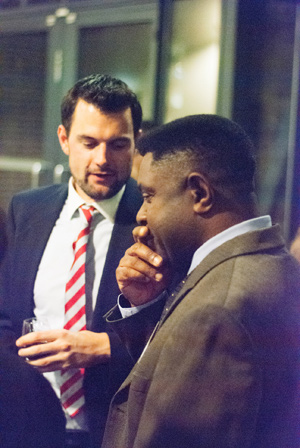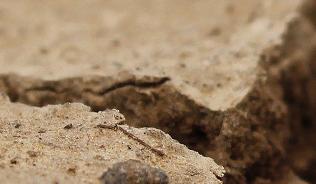At the Institution’s 2015 Annual General Meeting, held on the 1st May, we saw the end of the term of Dr Heather Barrett-Mold as Chair of the IES, and the election of new officers to positions on Council. Our sincere thanks must go to Heather for all that she has achieved during her three years in post, and we are pleased that she will be continuing her close relationship with the Institution, taking on the title of Vice-President.
We are also very pleased to welcome our new Chair, Dr Noel Nelson to the post, who was elected at the AGM. Noel was first elected to the IES Council in 2008, and served as Vice-Chair from 2012-2015. In the following paragraphs, Noel briefly introduces himself, and discusses some of his aspirations for his term as Chair…
I first became interested in environmental science after having worked at an alternative technology centre in Denmark between my ‘A’ Levels and Degree. Up until then I was heading towards a degree in Astrophysics with Maths. I came to the conclusion that working to improve the environment was perhaps a little more important. I made the decision to study a ‘strict’ science first (in Physics) before going on to obtain a Masters in Environmental Science. Several years later I found myself at the Met Office learning about how the atmosphere transports and dilutes material emitted within it.
While at the Met Office I was introduced to atmospheric dispersion modelling (mainly air quality impact assessments), climate change and the impact the weather may have on our health and wellbeing. Applied research in these areas gave me a good grounding in some aspects of the way our surroundings may impact on us as a society. Although this was valuable I felt I didn’t really understand how the science I was involved in was used within Government to formulate decisions, so I decided to undertake a secondment to a government department. This was a major eye-opening experience, in that it helped put into perspective the value of good science when applied to the formulation of policy. I was seconded from the Met Office to Defra’s air quality division. It very quickly became clear that the science was only one of the important areas of consideration for policy development. Evidence provided by science had to be equally considered along with evidence pertaining to financial implications and the impact on people and society (as well as business). Science was not the only major consideration.
My next job was a period of work with the Royal Commission on Environmental Pollution (RCEP). I had the privilege of working for this organisation as a member of the Secretariat and during my time with them I helped to contribute to several Command Reports. My time with the RCEP provided me with yet another opportunity to put things into perspective regarding the real value of science. It was interesting to note that science was often very good at alerting us to aspects of hazard in the environmental field but not necessarily at providing solutions to environmental problems. These problems appeared to be multidisciplinary in nature which contributed to many being considered as ‘wicked’ problems. Developing real lasting sustainable solutions often requires a mammoth effort bringing together different disciplines, world views and organisational methodologies. In the past, solutions which were developed within one focussed environmental discipline would result in problems in another area of the environment. Although many of us recognise this, developing real environmental improvement tends to be very fragmented. I believe one of the aspects required to bring about true environmental improvement is the adoption of a multidisciplinary approach to problem solving. I also believe that the Institution of Environmental Sciences is very well placed to be influential in this endeavour.
 Having left the RCEP shortly before they were disbanded (a terrible loss in my view), I returned to the Met Office where I am currently seconded to the Pirbright Institute investigating the role the atmosphere and the weather plays in transmitting a wide range of animal related diseases such as Foot and Mouth and Bluetongue. Even within this discipline, new ways of considering animal health within the wider umbrella of animal husbandry and how this is related to the wider health of the supporting ecosystems, brings me right back to the very ideals we hold prominently within the Institution of Environmental Sciences.
Having left the RCEP shortly before they were disbanded (a terrible loss in my view), I returned to the Met Office where I am currently seconded to the Pirbright Institute investigating the role the atmosphere and the weather plays in transmitting a wide range of animal related diseases such as Foot and Mouth and Bluetongue. Even within this discipline, new ways of considering animal health within the wider umbrella of animal husbandry and how this is related to the wider health of the supporting ecosystems, brings me right back to the very ideals we hold prominently within the Institution of Environmental Sciences.
At the start of my time as Chair I feel I owe a real debt of gratitude to Dr Heather Barrett-Mold who steered the IES through many changes during her term in the post. During this period the Institution has changed offices and has developed a more effective way of working as well as producing many very relevant and informative publications. I believe we are currently going through a period of significant improvement at the Institution thanks to the considerable work of our Project Office, who appear to be going from strength to strength, as well as the guidance offered by our Council Members. This, along with the appointment of our new President, Sir John Lawton, makes me feel confident that the Institution will continue to build on our successes of the past. During my time as Chair I will want to continue to engage with our Members to ensure we are providing them with the support they need and will be very happy to hear from them about ways in which we can improve our services. In collaboration with our Council and Project Office, I also look forward to investigating ways in which we can become more influential in bringing about environmental improvements.



